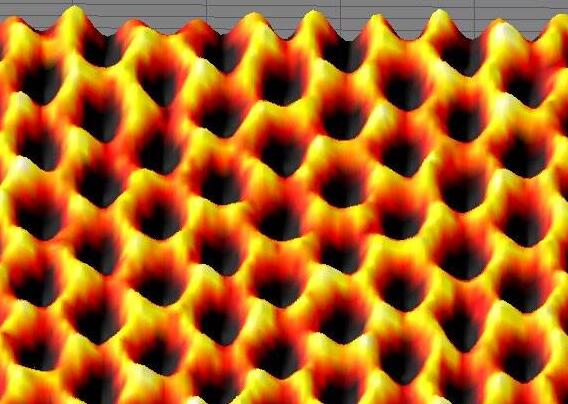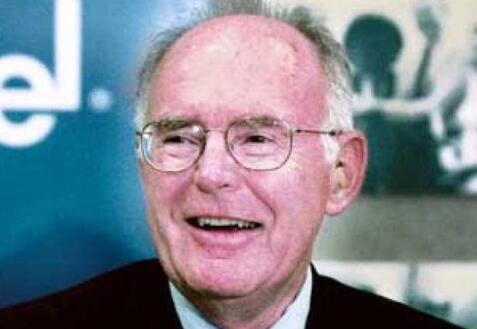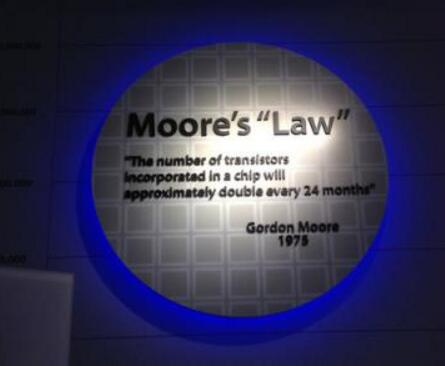Moore's Law was proposed by Gordon Moore, one of Intel's founders. The content is: When the price is constant, the number of components that can be accommodated on the integrated circuit will double every 18-24 months, and the performance will be doubled. In other words, the performance of computers that can be bought for every dollar will more than double every 18-24 months. This law reveals the speed of advances in information technology.
Although this trend has been going on for more than half a century, Moore's Law should still be considered observation or speculation, not a physical or natural law. The law is expected to continue until at least 2015 or 2020. However, the updated growth of the international semiconductor technology roadmap in 2010 has slowed down at the end of 2013, and the transistor density is expected to double every three years.

Moore's Law is embarrassed, not a strict law of science. More is, and cloud computing, etc., the semiconductor industry flickered for their own development.
"Moore's Law": Integrated circuits will double their integration every 18 months. This sentence is actually a joke that Moore said casually when he was eating turkey. He did not expect to be a golden rule after being boasted by Mead.
Mead touted Moore's Law, and he had his wishful thinking. One was because he and Moore were the brothers and sisters of Caltech, and the other was because Intel was a big company at the time, and Mead had to take research funding from Intel. Moore, I guess my heart is beautiful. I didn’t expect that I would like to become a law because I thought about how to put more spices into the turkey! Speaking of Mead, the reason why he can make a name for himself is to thank the "ç³ " in "Mi-Yi".

"Moore's Law" is the founder of Gordon Moore, one of the founders of the famous chip manufacturer Intel. The rapid development of the semiconductor manufacturing industry from the late 1950s to the early days led to Moore's Law. "The introduction."
As early as 1959, Fairchild, the famous semiconductor manufacturer in the United States, first introduced planar transistors, followed by planar integrated circuits in 1961. This planar manufacturing process uses a so-called "lithography" technique to form components of a semiconductor circuit, such as diodes, transistors, resistors, and capacitors, on a silicon wafer that is flattened. As long as the precision of "lithography" continues to increase, the density of components will increase accordingly, which has great potential for development. Therefore, the planar process is considered to be "the entire semiconductor industry bond" and is the technical basis for the advent of Moore's Law.
On April 19, 1965, Moore, who was the director of the research and development laboratory of Fairchild Semiconductor, was invited to write an observation and comment report for the 35th anniversary of "Electronics" magazine. The title was: "Let the integrated circuit fill more element". Moore should predict the development trend of the semiconductor component industry in the next decade. According to his calculations, by 1975, on a single silicon chip with an area of ​​only a quarter of an inch, it would be possible to intensively 65,000 components. He made this inference based on the linearity of the complexity of the device (the circuit density is increased and the price is reduced) and time. His original words are as follows: "The complexity of the lowest component price is increased by about one each year. Times.
It is convinced that this growth rate will continue in the short term. Even if it is not speeding up. The growth rate over a longer period of time should be slightly volatile, although there are good reasons to prove that this growth rate has remained almost constant for at least the next decade. This is the original prototype that was later called "Moore's Law."
Moore's Law EvolutionThe resounding reputation of Moore's Law has led many people to follow the way of expressing it, thereby deriving and multiplying various versions of "Moore's Law", such as:
Moore's second law: Moore's Law has been proposed for 30 years, the performance of integrated circuit chips has indeed been greatly improved; but on the other hand, Intel executives began to notice that the cost of chip production plants is also increasing accordingly. In 1995, Intel Chairman of the Board of Directors Robert Noys foresees that Moore's Law will be constrained by economic factors. In the same year, Moore wrote in the Economist magazine: "What makes me most worried now is the increase in cost, ... this is another index curve." This statement is called the second law of Moore.
New Moore's Law: In recent years, the emergence of the "new Moore's Law" in the domestic IT professional media refers to the increasing speed of the number of Internet-connected hosts and the number of Internet users in China, which is about doubled every six months! And experts predict that this trend will continue in the next few years.

For 40 years, we can see that due to the implementation of Moore's Law, we are able to obtain very high performance products at very low prices. For example, in 1971, Intel's first-generation microprocessor had 2,300 transistors, and by 2007 our 45-nm processor contained more than 800 million transistors. This is only one-millionth of the price of each transistor in 1968. It is because Moore's Law has brought extremely high-performance products at very low prices to stimulate the development of the entire electronics industry. Why do we discuss IP today? The address is not enough.
At the same time, Moore's Law has changed the landscape of the IT and communications communities. For example, we all know that in the field of communications, there are Chinese companies such as Huawei and ZTE that are the first to rise. They are of paramount importance in the field of communications. Why are Huawei and ZTE able to rise in the field of communications? And we did not see the same companies, for example, in the automotive industry. I think the big reason is because Moore's Law has changed the threshold of hardware cost in the field of communication, so that it does not require a lot of capital cost today, and does not require complicated efforts. It is a person who can make a switch. You can make a mobile phone. It is another thing to do well and not. This situation is hard to imagine without Moore's Law.
A few decades ago, only a few manufacturers in the world could make a switch. Today is far from such a pattern. This is because Moore's Law, in other words, there is no such industry as Huawei or the center in today's auto industry. It can be attributed to the fact that there is no law similar to Moore's Law in the automotive industry. People have been asking for 40 years, do we need so much computing power? How far can Moore's Law go? We live in a digital world where an MP3 file size of 3MB is equivalent to 24 million 0 and 1. We have seen that so far, we have not seen humans' hunger for computing power to be satisfied. This is the new computing power of the world to 2602 MIPS/p. If someone doubts our computing power, you can look at opening the notebook and closing the notebook. How much time it takes to actually open and close can know the specific answer.
Also, we believe that the future of the Internet will be the embedded Internet. In the beginning, it was a man-machine dialogue. It can be said that the address is a human population. In the future, due to the continuous application of Moore's Law, a lot of dialogues, like what we know, are no longer a dialogue with people. This is the problem that the IP address we discussed today is not enough.
We believe that in the future, there may be 15 billion Internet devices that need to be connected to the network. From here, more devices mean more transistors. By 2004, the number of transistors per capita in the world has reached 500 billion transistors per capita. Therefore, we believe that the demand for high computational complexity is far from reaching the limit.
At the same time, we also realize that it is not necessary to calculate such a high amount of time in every occasion. But when we pursued Moore's Law, we found that when we continued to reduce the size of integrated circuit transistors, we also found that other new good performance. For example, in 2005, when we reduced the integrated circuit from 65 nanometers to 45 nanometers to 2007, we found that not only the density of transistors was doubled, but the switching speed was increased by more than 20%. It is more than 30% lower, and the source drain leakage function is reduced by more than 5 times, which makes the mobile Internet possible.
Moore's Law will not be outdated, how far can Moore's Law go? This issue has been continually being asked for the past 40 years. For example, when we achieved 130 nanometers, the view at the time was that 90 nanometers was the limit. When we broke through 90 nanometers to achieve 45 nanometers, some people said that 45 nanometers is the limit. All predictions proved to be incorrect. . How far can Moore's Law go?
We see that as transistors continue to shrink in size, traditional technologies have brought the limits. There is a leakage. As the size of the transistor shrinks, we find that the leakage between the source and the drain is large. To overcome this phenomenon, it is necessary to have more effective control, more control over the polysilicon gate, so it is required to do a good job in the thickness of the gate tube. This brings about the problem of gate leakage, which is the bottleneck that gradually shrinks large loopholes.
In terms of Intel, after our continuous efforts, trials and innovations, we have finally made great breakthroughs in materials. We have found that high-k dielectrics and metal gates can be used to achieve breakthrough technology. In the words of Mr. Moore, the use of high-K dielectrics and metal gate materials is a major breakthrough in transistor materials in the last century. Because of this major breakthrough, we can achieve 45 nm or less from 65 nm. . Other manufacturers have not mastered such technology. From 65 to 45, they still use the evolution process as an evolutionary product, not as a revolutionary product.

The process of using high-k gate dielectrics at least extends Moore's Law for at least 10 years. In 2011, we can achieve 130 nanometers with the original power, 90 nanometers in 2003, and 65 nanometers in 2005. With high-k dielectrics, we can achieve 45 nanometers in 2007. Today we can Do it at 32 nm.
In fact, the difficulty of Moore's Law is very large. Some manufacturers say that I can do 45 nanometers, etc. It is one thing to do one on the laboratory integrated wafer. It is another time to achieve high yield. thing. In Intel's case, the lower the curve, the lower the defect rate, or the higher the yield. It can be seen that in Intel, our 65nm negative frequency is lower than 90nm, and the 45 defective rate is lower than 65nm. This curve is very steep, and Intel has greatly reduced the product's defect rate in a short period of time. Today, Intel's 45nm is mature, and we will enter the next generation of 32nm process technology from the fourth quarter of 2009.
In addition to process development techniques, there are six core technologies, including semiconductor process technology, product design technology, design tools, manufacturing processes, masking techniques, and packaging technologies. With packaging technology, there will be thousands of pins in a small rice grain. How to encapsulate it is the core technology. Intel has its own core competencies in all six technologies and has mastered all six key technologies.
In addition, Intel, as an innovator, aims to transcend itself. Just now I said that every two years, our manufacturing technology will break through to the next generation. Every two years, we will update the structure of our microsystem, just like the pendulum mode. In 2006, we introduced microarchitecture at 65 nm. In the next year, we will change from 65 nanometers to 45 nanometers under the same micro-architecture. In the same year, we will introduce Nehalem structure in 2008 at 45 nanometers. Under such circumstances, I will put 45 nanometers become 32 nanometers, non-stop innovation and development.
This year, during the global financial turmoil and financial tsunami, Intel announced in February this year that it invested 7 billion US dollars to start a 32-nanometer fab. In February, after President Obama heard the news, he called Intel's president P's hotel. President Obama told our CEO that the only thing I heard since I took office was a positive news. President Obama thanked Intel for investing in the future at this time. Specifically, in the diagram on the left-left corner, we are now producing 32-nanometer equipment at the D1D factory. Next in the fourth quarter of 2009, another of our factories was upgraded to 32 nanometers in D1C, Oregon. Next, do 32 nm in Fab, Arizona. The next step is to do 11X in Fab, New Mexico, and we will upgrade to a 22-nanometer factory. So we are constantly innovating. In the process of technological innovation, the challenges are getting harder and harder, the cost of capital is increasing, and the threshold is getting higher and higher. So far Intel is the only one in the world to start working on 32nm.
In 2009, we have now completed 32nm development work. Then, based on our current technology, we can see that we can achieve 22 nanometers in 2011. 22 nanometers are the same size as the virus, and then can continue to achieve 16 nanometers in 2013 and 11 nanometers in 2015. What is the concept, in the size of the transistor, the distance of the gate can be arranged 50 silicon atoms So big, then going down will encounter new challenges. So far we have seen that silicon or FETs are still the best electronic logic devices. After 2010, what we need to explore is that if silicon is not enough to support our continuous innovation, and continue to go down, will there be other raw materials to replace silicon. Or the most fundamental problem, everything we do is nothing more than two states of 01. We chose semiconductors to represent two states. For example, can you use other representatives? So this is the miles of our constant innovation. It can be seen that Moore's Law is the driving force behind the mobile Internet, or the driving force behind IPv6. From Intel, the past 40 years have been 40 years of continuous innovation, and it is a wonderful 40 years, because Intel has 40 years of history today. But the past 40 years have not been the best 40 years, because for an innovator, the best 40 years will always be the next 40 years.
Bluetooth Speakers,Bluetooth Speaker,Portable Speakers,Mini Speaker
Dongguan Guancheng Precision Plastic Manufacturing Co., Ltd. , https://www.dpowergo.com